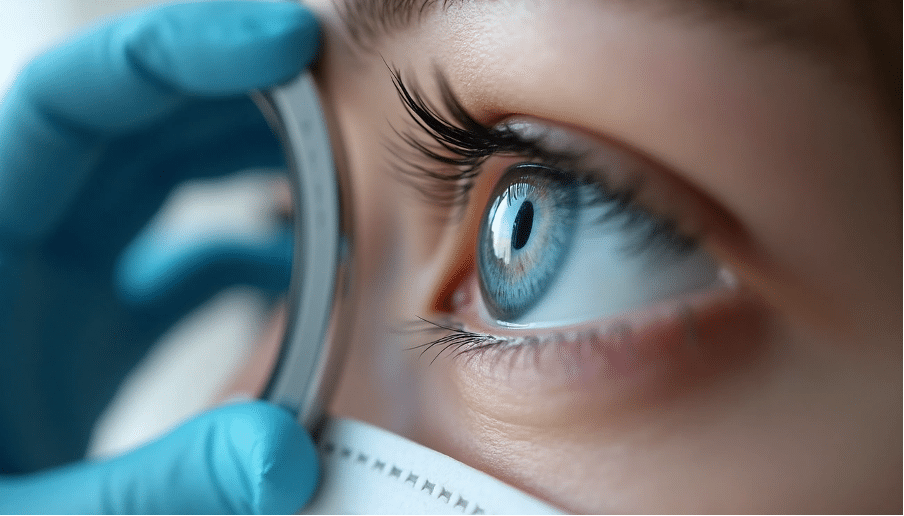Did you know that 95% of people can pass an eye test to the driving standard without glasses after refractive lens exchange recovery? Refractive lens exchange (RLE) provides unmatched long-term vision correction that typically lasts a patient’s lifetime when no other problems exist. Premium multifocal lenses help 80-93% of patients achieve complete freedom from glasses. But you need to understand what to expect during your recovery experience.
Patients experience mild discomfort after surgery. A slight irritation subsides within a few hours. Most people return to work within 48 hours, though their original vision may be blurry temporarily. Let us walk you through the refractive lens exchange recovery timeline, from surgery day to full healing. You’ll learn what to expect at each stage, how to handle discomfort, and when you can safely resume your normal activities.

Understanding the Refractive Lens Exchange Procedure
RLE is similar to modern cataract surgery, but with one key difference – doctors perform it to reduce dependency on glasses or contact lenses instead of removing a cloudy lens. This life-changing procedure has become more popular as a vision correction solution.
What is lens replacement and how does it work?
Your surgeon removes your eye’s natural lens and replaces it with a synthetic intraocular lens (IOL) during lens replacement surgery. The whole process takes only 15-30 minutes and you can go home the same day. The surgeon creates a tiny incision where the sclera and cornea meet. They use ultrasound technology to break up and remove your natural lens. Then they position the new IOL within your lens capsule.
You can choose between two main types of IOLs:
- Monofocal IOLs – designed to reduce spectacle dependence for distance vision
- Multifocal IOLs – want to reduce spectacle dependence for a wider range of activities, including intermediate (computer screens) and near (reading) vision
Who is a good candidate for RLE?
RLE might be right for you if you’re over 50 with a glasses prescription higher than the normal range for laser eye surgery. On top of that, it helps patients with presbyopia (age-related difficulty focusing on close objects) by a lot. Your surgeon can correct almost any level of myopia (short-sightedness) or hyperopia (long-sightedness) with RLE, plus astigmatism using specially designed IOLs. If you dream of freedom from glasses but can’t get laser vision correction, RLE could be your perfect solution.
How long does refractive lens exchange last?
RLE stands out because it lasts forever. The specialist intraocular lens stays strong and clear. So the results of RLE are meant to last a lifetime. The best part? You’ll never develop cataracts later in life because RLE replaces your natural lens. The IOL stays in your eye permanently, so you won’t need cataract surgery in the future. While RLE results last forever, other age-related eye conditions can still develop on their own. Regular eye check-ups remain essential even after your successful RLE surgery.
What to Expect on Surgery Day
Getting ready for your refractive lens exchange (RLE) surgery will give you the best results and help you recover faster. Let me walk you through everything you should know about your surgery day, from your first assessment to the end of the procedure.
Pre-operative preparation and consultation
Your ophthalmologist will schedule a detailed pre-operative evaluation that includes:
- A complete eye examination to spot any health issues
- A discussion about intraocular lens (IOL) options that match your lifestyle and vision needs
- Clear information about the benefits and potential risks of the procedure
- Your personalised treatment plan
You should take these steps to prepare for surgery:
- Put in the prescribed antibiotic eye drops for three days before surgery
- Stop wearing contact lenses in the eye scheduled for operation at least three days before
- Let your doctor know about any health changes, including colds or infections
- Make sure someone can drive you home after surgery since you won’t be able to drive
The procedure step-by-step
The RLE procedure on surgery day follows these steps:
- Your eye gets numbed with anaesthetic drops, and you might receive a mild sedative
- The surgeon makes a tiny self-sealing incision at the meeting point of your cornea and sclera
- A circular part of the lens capsule gets removed (capsulotomy)
- Ultrasound technology breaks down and removes your natural lens (phacoemulsification)
- Your chosen IOL goes through the same incision
- The surgeon positions the IOL in your lens capsule
- A protective shield covers your eye
The incision heals naturally without stitches because of its small size.
How long does lens replacement surgery take?
Each eye takes between 15 to 30 minutes for the RLE procedure. The surgery is quick but very precise and needs advanced technology and skilled surgeons. Most doctors operate on one eye first, then treat the second eye about a week later. In spite of that, some cases might qualify for same-day surgery on both eyes. You can head home the same day after a short monitoring period.
Recovery Timeline After RLE Surgery
The recovery timeline after refractive lens exchange moves quickly. Most patients see vision improvements within days after surgery. Knowing what each stage brings will help you prepare for a smooth recovery trip.
Day 1 to 3: Initial healing and vision changes
Most patients experience some discomfort when the anaesthetic wears off. Blurry or foggy vision happens right after surgery, which shouldn’t cause concern. Your eye starts healing during these vital first days. You might notice:
- Mild discomfort and sensitivity in your eye
- Vision clarity changes
- Glare or halos around lights
Recovery usually takes 2-3 days. Your surgeon will prescribe antibiotic and anti-inflammatory eye drops to help recovery. You’ll have a follow-up visit within 24-48 hours. This lets doctors check your eye pressure and monitor early healing progress.
Week 1 to 2: Adjusting to the new lens
Vision improves substantially for most patients by the first week. During this time:
- Most patients return to work within days
- You can drive once your consultant confirms your vision meets standards
- Light activities become possible, but avoid swimming
Your vision stabilises gradually, though some fluctuations occur as your brain adapts to the new lens. Most patients adapt well to their new lenses by their one-week follow-up appointment.
Week 3 to 4: Resuming normal activities
Your eye keeps adjusting and healing during this period:
- Regular activities can start again
- Swimming and water activities become possible (usually after 4 weeks)
- Remaining glare or halos decrease
Beyond 1 month: Full visual recovery and stability
Complete visual recovery takes 4-6 weeks, with full healing within eight weeks. Some patients might experience longer adaptation periods:
- Halos and strobes fade after 10-12 weeks
- Vision reaches complete stability
- Full adaptation might take months for some patients
Want to know your expected recovery time after refractive lens exchange? Precision Vision London’s expert team can create your personalised recovery roadmap. Book your consultation today and recover with confidence.
Managing Discomfort and Ensuring a Smooth Recovery
The success of your refractive lens exchange surgery depends on proper care after the procedure. Most patients recover smoothly, but knowing how to handle common side effects can make you more comfortable during recovery.
Common side effects and how to handle them
Your eyes might experience temporary side effects after RLE surgery. Here’s what you might notice:
- Light scatter effects like glare, halos, and ghost images
- Blurred or fluctuating vision
- Mild discomfort or grittiness
- Red blotches on the white of your eye
These symptoms usually get better within a few months. You can take over-the-counter painkillers like paracetamol or ibuprofen to manage any discomfort. Non-prescription sunglasses help if your eyes become sensitive to light.
Using eye drops and medications correctly
Your eye’s recovery depends on proper use of eye drops that prevent infection and reduce inflammation. Your surgeon will give you:
- Antibiotic eye drops (use for about a week)
- Anti-inflammatory eye drops (use for 3-6 weeks)
- Lubricating drops that help with dryness and irritation
Clean your hands really well before using the drops. Pull your lower eyelid down gently to make a pocket and put the drop in without touching your eye. Let two minutes pass between different types of drops.
When to seek medical advice
Call your eye specialist right away if you notice:
- Severe or worsening eye pain that medicine doesn’t help
- Sudden changes in vision or your eyesight gets much worse
- More redness, swelling or discharge from your eye
- Flashes of light or many new floaters appear suddenly
These signs could mean you need immediate medical help.
Follow-up appointments and monitoring progress
Your recovery needs regular check-ups with your doctor. The first check happens within 24-72 hours after your surgery. Later visits help track your healing and address any issues you might have. Make sure you go to all your scheduled appointments, even if your eyes feel fine. Problems that need treatment during healing might not be obvious to you. Your doctor will let you know when activities like driving are safe again.
Conclusion
Refractive lens exchange is a chance to break free from glasses, especially when you have crossed 50 or can’t opt for laser eye surgery. Most patients feel little discomfort and their vision improves substantially within days after surgery. Your recovery moves fast. You can return to work within 48 hours and pick up your regular activities after 3-4 weeks. Visual stability comes in 4-6 weeks. Some patients might notice halos for 10-12 weeks, but these effects fade away naturally as your brain adapts to the new lenses.
Without doubt, RLE’s permanent results are one of its biggest advantages. Your specialist intraocular lens stays stable for life, which means you’ll never develop cataracts. These long-term benefits explain why 95% of patients achieve driving-standard vision without glasses. Premium multifocal lenses help 80-93% of patients live completely free from spectacles.
Precision Vision London’s team understands each patient’s unique needs. Our expert surgeons combine advanced technology with personalised care throughout your recovery. RLE by our trusted specialists can revolutionise your vision for life, whether you want clearer distance vision or less dependence on reading glasses.
FAQs
Q1. How long does the recovery process typically take after refractive lens exchange surgery? Full visual recovery usually occurs within 4-6 weeks, with most patients experiencing significant vision improvement within the first week. However, complete adaptation may take up to 2-3 months for some individuals.
Q2. What are the key precautions to take during the recovery period? It’s important to avoid strenuous activities, protect your eyes from irritants and trauma, refrain from swimming for about 4 weeks, and follow your doctor’s instructions carefully. You should also use prescribed eye drops as directed and attend all follow-up appointments.
Q3. When can I resume normal activities after lens replacement surgery? Most people can return to work within a few days and resume light activities within the first week. However, it’s best to wait 3-4 weeks before engaging in more strenuous activities or water-based sports.
Q4. How soon after surgery will my vision improve? Vision improvement varies among patients. Some may notice clearer vision within hours, while for others, it may take up to two weeks. Expect some fluctuations in vision clarity during the initial recovery period.
Q5. Are there any common side effects I should be aware of following refractive lens exchange? Temporary side effects may include mild discomfort, blurred or fluctuating vision, and light scatter effects such as glare or halos. These symptoms typically improve within a few months. If you experience severe pain or sudden vision changes, contact your eye specialist immediately.
Authors & Reviewer
-
 Olivia: Author
Olivia: AuthorHi, I'm Olivia, a passionate writer specialising in eye care, vision health, and the latest advancements in optometry. I strive to craft informative and engaging articles that help readers make informed decisions about their eye health. With a keen eye for detail and a commitment to delivering accurate, research-backed content, I aim to educate and inspire through every piece I write.
-
 Dr. CT Pillai: Reviewer
Dr. CT Pillai: ReviewerDr. CT Pillai is a globally recognised ophthalmologist with over 30 years of experience, specialising in refractive surgery and general ophthalmology. Renowned for performing over 50,000 successful laser procedures.

